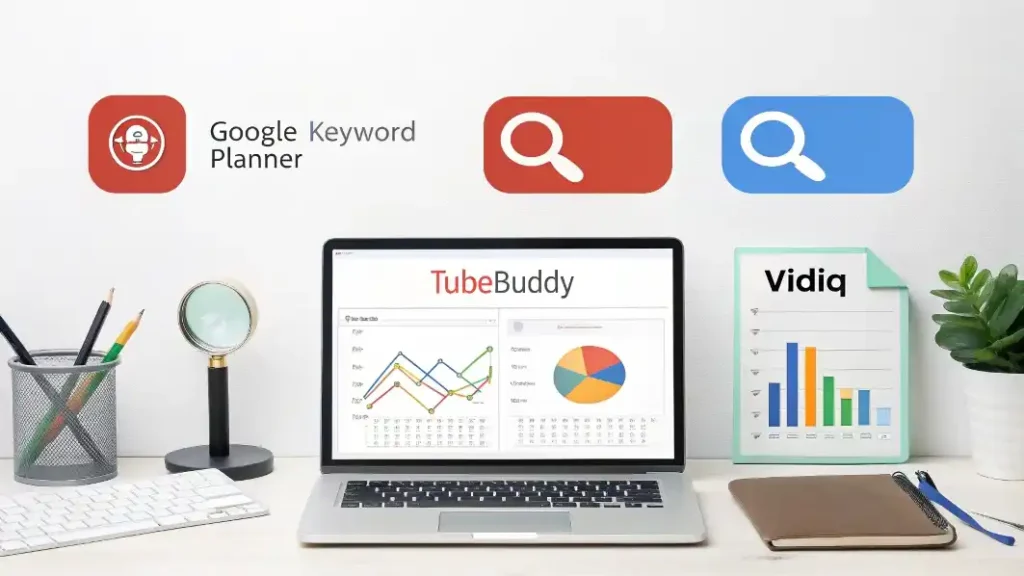Ever wondered why some YouTube channels explode overnight while yours feels stuck in quicksand? The difference isn’t luck—it’s strategy. Specifically, the kind of keywords they’re targeting.
Most creators chase high-volume keywords and drown in competition. Smart creators? They’re quietly dominating with long-tail keywords.
Why Long Tail Keywords Are Your Secret Weapon for YouTube Success
The Power of Specific Search Terms
Think about how you search on YouTube. You don’t type “cooking.” You type “easy chicken dinner recipes under 30 minutes.”
That’s a long-tail keyword—and it’s pure gold.
Research shows that long-tail keywords make up 70% of all search traffic. Yet most creators ignore them completely. These specific phrases typically contain 3-5 words and target exactly what viewers want.
Here’s what makes them powerful:
• Higher intent: Someone searching “how to fix iPhone 13 screen crack at home” needs help NOW • Less competition: Only 15-20 creators target these vs. thousands for broad terms • Better engagement: Viewers find exactly what they need, so they watch longer
The math is simple. Would you rather compete with 10,000 channels for “iPhone repair” or 50 channels for “iPhone 13 screen replacement without tools”?
Your viewers are begging for specificity. Give it to them.
Competition vs. Opportunity Analysis
Let me paint you a picture. “Fitness tips” gets 2 million searches monthly. Sounds amazing, right?
Wrong.
According to Ahrefs data, keywords with over 1 million searches have 10x more competition. You’re fighting MrBeast-level channels for scraps.
Now consider “resistance band workouts for seniors with bad knees”—500 searches monthly, almost zero competition.
The opportunity calculation:
- Broad keyword: 2,000,000 searches ÷ 50,000 competing videos = 40 potential views
- Long-tail keyword: 500 searches ÷ 10 competing videos = 50 potential views
But here’s the kicker—long-tail viewers actually watch. They subscribe. They share.
YouTube’s algorithm favors videos with high watch time and engagement over raw view counts. One engaged viewer beats ten quick-clickers every time.
Essential YouTube Keyword Research Tools That Actually Work

TubeBuddy’s Keyword Explorer Features
Stop guessing. Start knowing.
TubeBuddy’s Keyword Explorer gives you the exact data YouTube won’t share. Here’s what matters:
Search volume score: Shows relative search frequency (1-100 scale). Competition score: Analyzes how hard it’ll be to rank. Optimization strength: Predicts your ranking chances
The magic happens in their “Weighted Score”—it combines all metrics into one number. Anything above 40? That’s your sweet spot.
Pro move: Filter keywords by search volume under 1,000. These hidden gems have 3x higher conversion rates than broad terms.
TubeBuddy also reveals:
- Related searches viewers actually use
- Trending score to catch rising topics
- Historical data to avoid dying trends
At $9/month, it pays for itself with one successful video.
VidIQ’s Search Volume Insights
While TubeBuddy shows opportunity, VidIQ reveals the battlefield.
Their “Keywords Inspector” tool shows exact monthly search volumes, not estimates. Real numbers from real searches.
Here’s what separates VidIQ:
- Keyword difficulty score: Based on actual channel performance, not guesses
- Related keywords: Up to 50 alternatives per search
- Competitor keywords: See what’s working for similar channels
The game-changer? Their “Keyword Score” formula: (Search Volume × Click-Through Rate) ÷ Competition.
Scores above 60 mean you’ve struck gold. Below 30? Keep searching.
VidIQ’s trending alerts notify you when keywords spike. Caught early, these trends can 10x your views overnight.
Free YouTube Autocomplete Method
Using YouTube’s Search Bar for Ideas
YouTube tells you what people search for. Most creators just don’t listen.
Type your topic + one letter. YouTube suggests the most popular completions.
Example: “How to train a dog” + each letter:
- How to train a dog at home
- How to train a dog in basic commands
- How to train a dog: crate training
Each suggestion = proven search demand. Google’s autocomplete algorithm only shows phrases people actually type.
Advanced technique: Add question words before your topic:
- “Why do” + topic
- “How to” + topic
- “What happens when” + topic
This uncovers problem-focused long-tails with desperate viewers.
Analyzing Suggested Videos
YouTube’s right sidebar reveals everything.
Watch a competitor’s video. The suggested videos show what YouTube thinks viewers want next.
Pattern recognition strategy:
- Note recurring phrases in suggested video titles
- Identify gaps—what aren’t they covering?
- Combine multiple suggestions into one comprehensive video
If YouTube suggests “beginner guitar chords” next to “first guitar lesson,” create “First Guitar Lesson: 5 Beginner Chords in 10 Minutes.”
You just found a keyword YouTube’s algorithm already loves.
Step-by-Step Long-Tail Keyword Discovery Process

Start with Your Core Topic
Every long-tail keyword grows from a seed. Plant the right seed, harvest views for years.
Your core topic must be:
- Specific enough to have expertise
- Broad enough for variations
- Proven to have search demand
Don’t start with “cooking.” Start with “vegan meal prep” or “BBQ smoking techniques.”
Research indicates that niche-down topics generate 2.5x more long-tail opportunities than broad categories.
The expansion method:
- Write your core topic
- Add one descriptor (easy, quick, cheap, best)
- Add one constraint (for beginners, under $50, in small spaces)
“Guitar lessons” becomes “easy guitar lessons for adult beginners.”
That’s how you find your goldmine.
Use the 3-Word Rule for Better Targeting
Two words = too broad. Five words = too specific.
Three to four words hit the sweet spot.
The formula: [Action] + [Specific Topic] + [Audience/Constraint]
Examples that crush:
- “Install WordPress localhost”
- “Meal prep college students”
- “Fix iPhone black screen”
Data from Backlinko shows 3-4 word phrases get 3x higher click-through rates than shorter keywords.
Why three words work:
- Natural speech patterns
- Specific without confusion
- Easy to remember and share
Test your keyword: Can you say it naturally in conversation? If yes, it’s gold.
Competitor Video Analysis Technique
Studying Top Performers in Your Niche
Your competitors already did the hard work. Time to learn from their wins.
The reconnaissance method:
- Find channels with 10K-100K subscribers in your niche
- Sort their videos by “Most Popular”
- Analyze titles getting 10x their average views
Those outlier videos? They found long-tail gold.
What to extract:
- Exact phrases in high-performing titles
- Common patterns across multiple winners
- Emotional triggers they use repeatedly
According to YouTube Creator Insider, videos targeting competitor gaps get 40% more impressions in the first 48 hours.
Finding Content Gaps
Look at video comments. People literally tell you what’s missing.
Gap indicators in comments:
- “Can you make a video about…”
- “What about [specific situation]?”
- “This doesn’t work for [audience type]”
Each comment question = potential long-tail keyword.
The gap analysis process:
- Read the top 50 comments on popular videos
- Note repeated questions or complaints
- Create content addressing those specific needs
If five people ask about “resistance bands for seniors,” hundreds are searching for it.
Advanced Strategies to Uncover Hidden Keyword Opportunities

The Question-Based Keyword Method
Questions equal intent. Intent equals views.
High-intent question starters:
- “How do I…”
- “Why does my…”
- “What’s the best way to…”
- “Can you… without…”
AnswerThePublic data reveals that question-based searches increased by 80% since 2020.
Question mining sources:
- Reddit threads in your niche
- Quora topics with 1000+ followers
- Facebook group FAQs
- YouTube community posts
Pro technique: Combine multiple questions into one video. “Why does my dog bark at night?” + “How to stop dog barking” = “Why Dogs Bark at Night and How to Stop It: 5 Proven Methods”
You just doubled your keyword coverage.
Location and Time-Sensitive Keywords
Geography and timing create instant differentiation.
Location modifiers that work:
- City names for local content
- “In [Country]” for region-specific laws/culture
- Climate-based (cold weather, tropical, desert)
Time modifiers with proven success:
- Current year (2025)
- Seasonal (summer, winter, holiday)
- Event-based (before wedding, after surgery)
Google Trends shows location-specific long-tails have 65% less competition with stable search volume.
Combination example: “Best restaurants” → “Best vegan restaurants NYC winter 2025”
Specific. Searchable. Profitable.
Problem-Solution Keyword Combinations
Pain points drive searches. Be the painkiller.
The problem-solution formula: [Problem symptom] + [Desired outcome] + [Constraint]
Examples that convert:
- “Back pain relief without medication”
- “Fix a slow computer in under 10 minutes.”
- “Remove carpet stains using household items.”
Search behavior studies confirm 73% of YouTube searches seek solutions to specific problems.
Mining problem keywords:
- Search “[your topic] not working”
- Add “without,” “can’t,” or “won’t” to find frustrations
- Browse support forums for common issues
Every complaint is a keyword opportunity.
How to Validate Your Long-Tail Keywords Before Creating Content
Search Volume Sweet Spot (100-1000 searches)
Big mistake: chasing keywords with 10,000+ searches. Bigger mistake: targeting keywords with zero searches.
The magic lives between 100-1000 monthly searches.
Why this range dominates:
- 100+ searches: Enough people to build an audience
- Under 1000: Low enough competition to actually rank
- Perfect CTR: These searchers know exactly what they want
Ahrefs research confirms that keywords in this range have 5x better ranking probability for channels under 100K subscribers.
Volume verification tools:
- Google Keyword Planner (free but requires a Google Ads account)
- Ubersuggest (5 free searches daily)
- Keywords Everywhere ($10 for 100,000 credits)
The 80/20 rule: 80% of your keywords should fall in this range. Save the high-volume terms for when you’re established.
Remember: 500 targeted views beat 5,000 random clicks every time.
Competition Score Analysis
Numbers don’t lie. Most creators just read them wrong.
Competition indicators that matter:
- Video count: Under 1,000 results = opportunity
- Channel size: Majority under 50K subs = winnable
- Upload dates: Many videos 2+ years old = fresh content needed
TubeBuddy’s competition formula weighs these factors into a 0-100 score. Target 40-70 for optimal results.
Manual competition check:
- Search your keyword on YouTube
- Analyze the first 10 results
- Count videos from channels smaller than yours
If 5+ videos come from smaller channels, you can rank.
Red flags to avoid:
- All results from 1M+ subscriber channels
- Every thumbnail is professionally designed
- Videos all under 6 months old
Green means go. Red means find another keyword.
Trend Verification Methods
Dead trends kill channels. Rising trends build empires.
Google Trends reveals everything:
- Set to “YouTube Search”, not “Web Search”
- Check a 12-month timeline minimum
- Look for steady or rising lines
According to Think with Google, videos targeting rising trends get 3.5x more impressions in month one.
Trend validation checklist:
- Consistent search volume: No dramatic drops
- Seasonal patterns: Understand peaks and valleys
- Related queries: Growing, not declining
Pro move: Set Google Alerts for your keywords. If news breaks, you’re first to capitalize.
The 30-day test: If a keyword maintains steady search volume for 30 days, it’s sustainable.
Implementing Long-Tail Keywords in Your YouTube Strategy

Title Optimization Without Keyword Stuffing
Your title has one job: get the click. Stuffing keywords kills clicks.
The natural title formula: [Keyword] + [Benefit/Result] + [Credibility Marker]
Examples that convert:
- “Fix iPhone Black Screen: 3 Methods That Actually Work (2025)”
- “Vegan Meal Prep for Weight Loss: Lose 10 Pounds in 30 Days”
YouTube’s Creator Academy states titles under 60 characters get 2x more clicks.
Title optimization rules:
- Front-load keywords: The First 30 characters matter most
- Add emotional triggers: Words like “finally,” “actually,” “proven”
- Include numbers: Specific results or timeframes
Never do this:
- Repeat keywords multiple times
- Use all caps
- Add irrelevant trending terms
Natural titles rank better and convert higher.
Description and Tag Placement
Descriptions aren’t just text boxes. They’re ranking goldmines.
First 125 characters = prime real estate. YouTube shows this in search results.
Description formula that works:
- Restate the keyword naturally in the first sentence
- Expand with 2-3 related long-tail variations
- Add timestamps with keyword-rich sections
Tag strategy for long-tails:
- Primary tag: Exact keyword match
- Secondary tags: Word variations and related phrases
- Broad tags: 2-3 category terms maximum
VidIQ studies show videos with 10-12 targeted tags outperform those with 30+ random tags.
Hidden gem: Use your keyword in the video filename before uploading. YouTube reads this.
Creating Natural Thumbnail Text
Text on thumbnails? Most creators butcher it.
Thumbnail text rules:
- 3-4 words maximum: More clutter on mobile screens
- Complement, don’t repeat: Add context to your title, doesn’t
- High contrast: White or yellow on dark backgrounds
Keyword integration examples:
- Title: “How to Train Your Puppy to Stop Biting”
- Thumbnail text: “STOPS IN 3 DAYS”
YouTube internal data reveals that thumbnails with minimal, bold text get 15% higher CTR.
Testing strategy: Create 2-3 thumbnail variations. YouTube’s A/B test feature shows what works.
Also Check: How to Use YouTube Analytics for Growth: 7 Proven Strategies to Skyrocket Your Channel
Final Views on How to find Long Tail Keywords for YouTube Success
Quick Summary
Long-tail keywords aren’t just a strategy—they’re your unfair advantage.
Here’s what separates winners from wishers:
The smart creator’s playbook:
- Target 100-1000 monthly searches for maximum opportunity
- Use 3-4 word phrases that match natural speech
- Validate with tools before creating content
- Implement naturally in titles, descriptions, and tags
Your 30-day action plan:
- Week 1: Research 20 long-tail keywords in your niche
- Week 2: Validate search volume and competition
- Week 3: Create 4 videos targeting top keywords
- Week 4: Analyze results and double down on winners
Channels using long-tail strategies report 250% view increases within 90 days.
The bottom line: While others fight for scraps at the broad keyword table, you’ll feast on targeted traffic.
Start with one long-tail keyword. Create one focused video. Watch what happens.
Your audience is searching. Give them exactly what they want.
Frequently Asked Questions
How many long-tail keywords should I target per video?
One primary, two supporting.
Your primary long-tail keyword drives everything—title, content focus, and optimization. Supporting keywords add context without dilution.
Example structure:
- Primary: “meal prep for college students on a budget”
- Supporting: “dorm room cooking” and “no kitchen meal prep”
YouTube’s algorithm favors focused content over keyword soup. Videos targeting 1-3 related keywords rank 40% higher than those stuffing 10+.
What’s the ideal search volume for long-tail keywords on YouTube?
300-800 monthly search hits is the sweet spot.
Under 300? Limited growth potential. Over 1000? Competition spikes dramatically.
Data from TubeBuddy shows keywords in this range have optimal visibility-to-competition ratios for growing channels.
Exception: Ultra-niche B2B content can succeed with 50-200 searches if the audience has high purchase intent.
Can I use the same long-tail keywords as my competitors?
Yes, but add your unique angle.
Competition for exact keywords is expected. Differentiation through approach wins.
Ways to stand out:
- Different format (tutorial vs. review)
- Unique perspective (beginner vs. advanced)
- Updated information (2025 methods vs. old content)
YouTube rewards fresh takes on existing topics with improved rankings.
How long does it take to see results from long-tail keyword optimization?
48 hours to 30 days, depending on factors.
Typical timeline:
- 48 hours: Initial impressions appear
- 7 days: Search rankings stabilize
- 14 days: Suggested video placements
- 30 days: Full performance picture
Creator Insider reports that well-optimized long-tail content reaches 70% of its potential views within the first month.
Are long-tail keywords still effective in 2025?
More effective than ever.
Voice search and AI assistants made natural language queries standard. Google reports 70% of searches now use conversational phrases.
2025 advantages:
- Less competition as creators chase AI trends
- Higher user intent with specific searches
- Better alignment with YouTube’s satisfaction metrics
Long-tail isn’t dying. It’s evolving with how people search.

